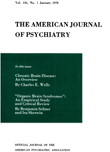PSYCHIATRIC ILLNESS IN HOSPITALIZED CATHOLIC RELIGIOUS
Abstract
Case histories of 200 Catholic religious, 100 priests and 100 nuns, consecutively discharged from a private psychiatric hospital, have been studied in relation to more than 50 variables. The case histories of 100 laymen and 100 laywomen, consecutively discharged from the same hospital, have been used for comparison. Questionnaires administered to 100 seminarians and 100 sisters without psychiatric illness have been used for additional comparative data.
It has been found that diagnoses, major symptomatology, and age of onset of illness differed considerably between the two patient groups. Socio-economic back-ground, school achievement, and parental influence also differed significantly. In these factors, the lay patients more closely resembled the non-patient religious group than the religious patients. The duration of hospitalization and patient attitude toward treatment differed significantly between the religious and lay patients.
Psychiatric evaluation and treatment of religious candidates could do much to alleviate the unhappiness that results from a commitment which creates conflicts. A healthier attitude toward psychiatry on the part of religious superiors could do much to alleviate the guilt and the scorn incurred by those who need such care.
Access content
To read the fulltext, please use one of the options below to sign in or purchase access.- Personal login
- Institutional Login
- Sign in via OpenAthens
- Register for access
-
Please login/register if you wish to pair your device and check access availability.
Not a subscriber?
PsychiatryOnline subscription options offer access to the DSM-5 library, books, journals, CME, and patient resources. This all-in-one virtual library provides psychiatrists and mental health professionals with key resources for diagnosis, treatment, research, and professional development.
Need more help? PsychiatryOnline Customer Service may be reached by emailing [email protected] or by calling 800-368-5777 (in the U.S.) or 703-907-7322 (outside the U.S.).



